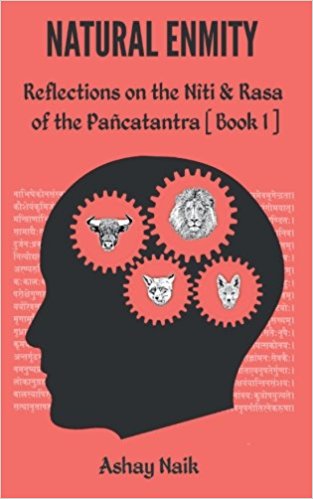A commentary on the Panchatantra that is free from alien ideological lenses.

Before coming to the book itself, something about author and his previous work which led me to purchasing the book.
I was introduced to Ashay Naik’s writings earlier this year in the wake of Rajiv Malhotra’s “Battle for Sanskrit”. He beautifully summarized the differences between the respected Shatavadhanin R Ganesh and Rajiv Malhotra approach to the Pollock problem. Subsequently I have been reading his other articles on Swarajya and Indiafacts, and more recently through his excellent blog .
Ashay is an excellent writer. He has a formal training in Philosophy, especially Indian Philosophy. Furthermore, his knowledge of Sanskrit ensures that he can delve into the primary material as opposed to the dispensing opinions based on secondary sources.
Ashay has been working on a book on Panchatantra, which is an offshoot of his thesis, if I am not mistaken.
Now coming to the book itself: In the introduction, the author draws our attention to how the approach sought by the characters in Panchatantra is different from the Revolutionary approach that is encouraged by the Western narrative, both on the left and the right, that seeks to conceive an ideal (or normative) goal and employs various strategies to achieve this. As the author points out, as per these approaches, the dominant narrative is that the world is a problem which needs to be fixed. The solution envisioned is typically a Utopian one which promises to get rid of the problem once and for all. As opposed to this, the alternate view is that the no matter which order is sought to be imposed, it is always susceptible to corruption, thereby resulting in oppressors and oppressed. And hence, wisdom lies in working with the world to ensure that one does not get oppressed. Thus, the politics in Panchatantra, is not based on ideology but on kinship. And hence, the hierarchy of family, community, jAti, etc become relevant in this kind of a setting.
The second important distinction that the author highlights in the introduction pertains to the dominant values. The Modern world holds equality, political liberty and economic independence. Thus reading the text using this lens leads to two kinds of faults : 1) Critics cherry-picking instances from the story to highlight how the text deviates from the aforementioned triad of values. 2) Apologists trying to force-fit the narratives in Panchatantra to justify the triad. Both approaches fail to reveal to us what the text has to say about the various issues it aims to tackle. The author identifies an alternate conservative triad of values that characterize the world of Panchatantra, namely , social hierarchy, political despotism and kinship communities.
The readers of Panchatantra should be familiar with the main story involving the the bull Sanjivaka, the jackal Damanaka and the Lion King Pingalaka. As the story goes forth, each character illustrates a nIti related point using an allegorical story. In this commentary, the author devotes the first half entirely to the main story arc and tackles the stories within the main story in the second half. I found this approach to be very useful since the context remains intact and helps us follow the author’s commentary better. The writing is smooth, and the author touches upon situations from day-to-day lives to explain a certain concept better.
The second half is devoted to the various stories that are told by the characters within the main story. Each of these stories can be independently read and there’s something to understand for the lay reader. One can read these portions in any order. Personally I liked the commentary on two stories “Gorabha and Dantila” and “The Ascetic, the Jackal and the Bawd”. Both these stories bring out a refreshing perspective with respect to the view of the Ancient texts on strI charitra. This is another instance where the author highlights the importance of approaching classics such as the Panchatantra bereft of various ideological lenses such as libertarianism, feminism etc that are in vogue today. Thus rather than be an apologist for the narratives, the author tackles these issue head-on in a bold and unabashed manner.
The book is not only about nIti, but also about illustrating the rasa that can be found in the Panchatantra. The narrative itself uses several allegorical stories, but it is abound with similes and metaphors, some of which have entered into our day-to-day speech in the form of aphorisms/gAde-mAtu/muhAvraas. The author does a good job of commenting upon these without spoiling it for the reader by over-dissecting them.
I would highly recommend this book for anyone who wishes to understand Panchatantra for what it says rather that what we would like it to say.
